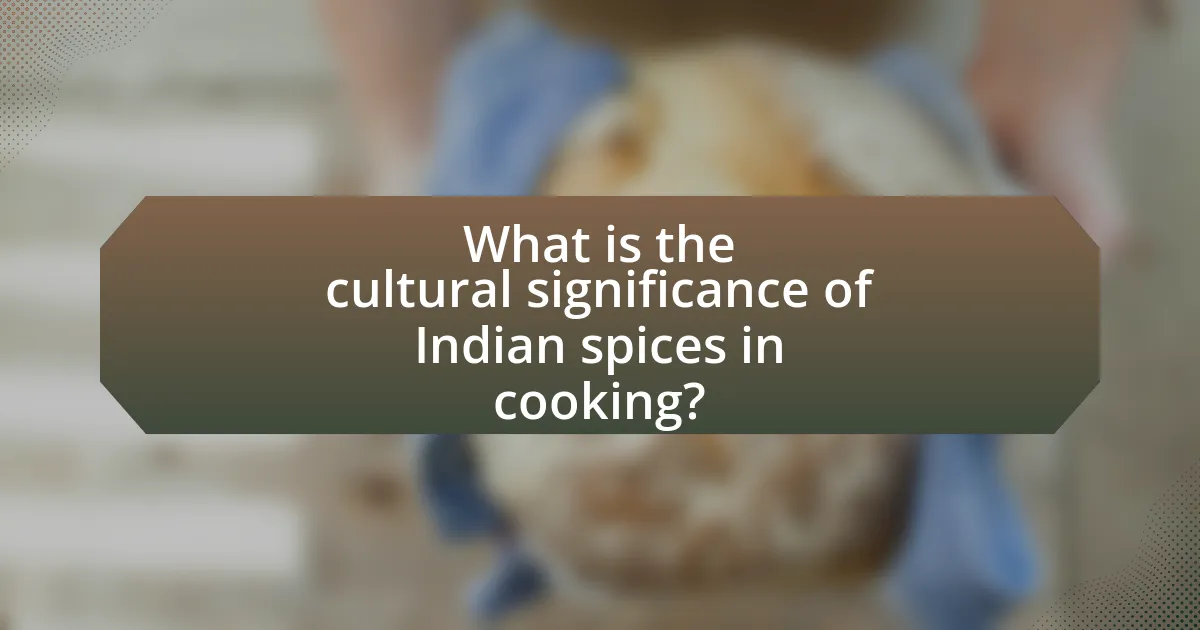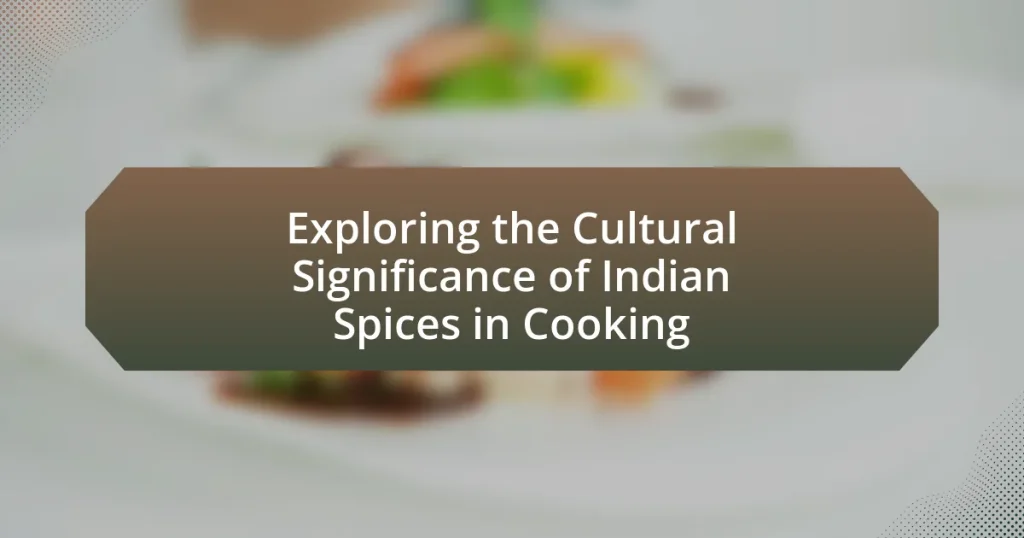The article explores the cultural significance of Indian spices in cooking, highlighting their role as essential components of culinary identity and tradition. It examines how spices like turmeric, cumin, and coriander not only enhance flavor but also carry historical and medicinal importance, reflecting India’s diverse regional practices. The discussion includes the influence of historical events on spice usage, regional variations in culinary practices, and the health benefits associated with these spices. Additionally, the article addresses modern trends in the integration of Indian spices into global cuisines and their impact on health and wellness, showcasing their enduring relevance in both traditional and contemporary cooking.

What is the cultural significance of Indian spices in cooking?
Indian spices hold immense cultural significance in cooking, serving as a vital element of culinary identity and tradition. These spices, such as turmeric, cumin, and coriander, are not only used for flavor but also carry historical and medicinal importance, reflecting the diverse regional practices and beliefs across India. For instance, turmeric is revered for its anti-inflammatory properties and is often used in religious rituals, symbolizing purity and prosperity. The use of spices in Indian cuisine also represents the country’s rich history of trade and cultural exchange, as spices were once highly sought after on global trade routes, influencing culinary practices worldwide. This deep-rooted connection between spices and cultural heritage underscores their role in communal gatherings, festivals, and daily meals, making them integral to the Indian way of life.
How have Indian spices influenced culinary traditions?
Indian spices have profoundly influenced culinary traditions worldwide by introducing unique flavors, aromas, and health benefits. The use of spices such as turmeric, cumin, and cardamom has transformed dishes across various cultures, enhancing taste and nutritional value. For instance, turmeric contains curcumin, known for its anti-inflammatory properties, which has led to its incorporation in global cuisines for health benefits. Additionally, the spice trade historically facilitated cultural exchanges, allowing spices to be integrated into local cooking practices, as seen in the adoption of curry flavors in British cuisine during the colonial era. This cross-cultural integration highlights the significant role Indian spices play in shaping culinary diversity and traditions globally.
What historical events shaped the use of spices in Indian cuisine?
The use of spices in Indian cuisine has been significantly shaped by historical events such as the ancient trade routes, the arrival of foreign invaders, and colonialism. The spice trade, particularly during the 1st century CE, established India as a central hub for spices like black pepper and cardamom, which were highly sought after in global markets. The arrival of the Mughals in the 16th century introduced new spices and cooking techniques, blending Persian and Indian culinary traditions. Additionally, British colonialism in the 18th and 19th centuries further influenced Indian cuisine by introducing new ingredients and altering spice usage, as the British sought to control the lucrative spice trade. These events collectively contributed to the rich tapestry of flavors and culinary practices in Indian cuisine today.
How do regional variations affect spice usage in India?
Regional variations significantly influence spice usage in India, as different regions have distinct culinary traditions and local ingredients. For instance, in North India, spices like cumin, coriander, and garam masala are prevalent, reflecting the region’s rich Mughlai and Punjabi cuisines. In contrast, South Indian cooking often features mustard seeds, curry leaves, and tamarind, which are integral to dishes like sambar and rasam. This diversity is further supported by the geographical availability of spices; for example, coastal areas utilize more seafood and spices like coconut and curry leaves, while arid regions may rely on dried spices for preservation. The cultural significance of these spices is evident in regional festivals and rituals, where specific spices are used to enhance traditional dishes, showcasing the deep-rooted connection between geography, culture, and culinary practices in India.
Why are spices considered essential in Indian cooking?
Spices are considered essential in Indian cooking because they enhance flavor, aroma, and color, making dishes more appealing and complex. The diverse range of spices used in Indian cuisine, such as cumin, coriander, turmeric, and cardamom, not only contribute to the sensory experience but also have historical significance, as they have been integral to Indian culinary traditions for thousands of years. For instance, turmeric is known for its anti-inflammatory properties, while cumin aids digestion, showcasing the health benefits associated with these spices. This combination of flavor enhancement and health benefits solidifies the role of spices as a cornerstone of Indian cooking.
What roles do spices play in flavor enhancement?
Spices play a crucial role in flavor enhancement by adding complexity, depth, and balance to dishes. They contain volatile compounds that contribute to aroma and taste, which can elevate the overall sensory experience of food. For instance, spices like cumin and coriander provide earthy notes, while chili peppers add heat, creating a harmonious blend of flavors. Research indicates that spices can also stimulate appetite and enhance the perception of taste, making meals more enjoyable. Studies have shown that the use of spices in cooking can lead to increased satisfaction and preference for certain dishes, highlighting their importance in culinary practices, particularly in Indian cuisine where spices are integral to traditional recipes.
How do spices contribute to health and wellness in Indian cuisine?
Spices in Indian cuisine significantly contribute to health and wellness by providing various medicinal properties and enhancing nutritional value. For instance, turmeric contains curcumin, known for its anti-inflammatory and antioxidant effects, which can help reduce the risk of chronic diseases. Similarly, cumin aids digestion and has antimicrobial properties, while ginger is effective in alleviating nausea and improving gut health. Research published in the Journal of Ethnopharmacology highlights that many spices used in Indian cooking possess bioactive compounds that promote overall health, supporting the idea that these ingredients are not only flavor enhancers but also vital components of a healthy diet.
What are the most commonly used Indian spices?
The most commonly used Indian spices include cumin, coriander, turmeric, mustard seeds, and cardamom. Cumin is often used for its earthy flavor, while coriander adds a citrusy note. Turmeric is known for its vibrant color and health benefits, mustard seeds provide a pungent kick, and cardamom is valued for its aromatic sweetness. These spices are integral to Indian cuisine, contributing to the rich flavors and cultural heritage of the region.
What unique flavors do these spices bring to dishes?
Indian spices bring a diverse array of unique flavors to dishes, enhancing culinary experiences with their distinct profiles. For example, cumin adds a warm, earthy taste, while coriander contributes a citrusy, slightly sweet flavor. Turmeric imparts a mild bitterness and vibrant color, and cardamom offers a sweet, aromatic quality. These spices not only elevate the taste but also reflect the rich cultural heritage of Indian cuisine, where each spice is often used for its specific flavor and health benefits. The use of these spices can be traced back thousands of years, showcasing their integral role in traditional cooking practices across India.
How are these spices sourced and processed?
Spices are sourced from various regions in India, where they are cultivated in specific climates and soil conditions that enhance their flavor and quality. Farmers harvest these spices at optimal ripeness, ensuring maximum potency. After harvesting, the spices undergo processing, which includes cleaning, drying, and grinding, depending on the type of spice. For instance, turmeric is boiled and dried before being ground into powder, while whole spices like cardamom are simply dried. This processing not only preserves the spices but also enhances their shelf life and flavor profile, making them suitable for culinary use.

How do Indian spices reflect cultural identity?
Indian spices reflect cultural identity by embodying the diverse traditions, regional practices, and historical influences of the subcontinent. Each spice, such as turmeric, cumin, and cardamom, carries unique significance tied to local customs, religious practices, and culinary techniques, showcasing the rich tapestry of Indian heritage. For instance, turmeric is often used in Hindu rituals, symbolizing purity and prosperity, while the use of spices in regional dishes highlights the agricultural diversity and climate variations across India. This connection between spices and cultural practices illustrates how food serves as a medium for expressing identity, community values, and social cohesion.
In what ways do spices symbolize regional diversity?
Spices symbolize regional diversity by reflecting the unique agricultural practices, climate conditions, and cultural traditions of different areas. For instance, the use of cardamom in Kerala’s cuisine highlights the region’s tropical climate and its historical trade connections, while the prevalence of mustard seeds in Punjabi dishes showcases the agricultural landscape of northern India. Additionally, spices like saffron, primarily found in Kashmir, represent the region’s specific climatic conditions and cultural heritage. These examples illustrate how spices serve as indicators of local identity, agricultural diversity, and historical influences, thereby reinforcing the rich tapestry of regional culinary practices across India.
How do festivals and celebrations incorporate spices in cooking?
Festivals and celebrations incorporate spices in cooking by using them to enhance flavors and symbolize cultural heritage. In Indian festivals like Diwali and Holi, spices such as cumin, coriander, and turmeric are integral to traditional dishes, reflecting regional diversity and culinary practices. For instance, during Diwali, sweets flavored with cardamom and saffron are prepared, signifying prosperity and joy. The use of spices not only elevates the taste but also connects communities through shared culinary traditions, as seen in the preparation of biryanis and curries during weddings and religious ceremonies. This practice is rooted in historical significance, where spices were once considered valuable commodities, further embedding them into the cultural fabric of celebrations.
What stories and traditions are associated with specific spices?
Cinnamon is associated with ancient trade routes, where it was highly valued and often considered more precious than gold. In Indian culture, it is used in various traditional dishes and is believed to have medicinal properties, symbolizing warmth and prosperity. Turmeric, known as “haldi,” is integral to Hindu rituals and weddings, representing purity and auspiciousness. Its vibrant color is linked to fertility and prosperity in many Indian traditions. Cardamom, often referred to as the “queen of spices,” has a rich history in Indian folklore, where it is said to have been used in royal kitchens and is believed to enhance love and attraction. Each of these spices carries deep cultural significance, reflecting their historical importance and the traditions surrounding their use in Indian cooking.
How do spices connect generations in Indian households?
Spices connect generations in Indian households by serving as a vital link in culinary traditions and family recipes. These spices are often passed down through generations, embodying the history and culture of the family. For instance, specific spice blends used in traditional dishes are frequently taught by elders to younger family members, ensuring that the flavors and techniques are preserved. This transmission of knowledge not only fosters a sense of identity but also strengthens familial bonds, as cooking together becomes a shared experience. Research indicates that the act of cooking with spices can evoke memories and emotions, further solidifying the connection between generations.
What role do spices play in family recipes and heritage?
Spices play a crucial role in family recipes and heritage by serving as a medium for cultural expression and tradition. They not only enhance the flavor of dishes but also carry historical significance, often reflecting the geographical and cultural backgrounds of families. For instance, in Indian cuisine, spices like turmeric and cumin are integral to recipes passed down through generations, symbolizing familial bonds and cultural identity. The use of specific spices can indicate regional origins and personal stories, reinforcing the connection between food and heritage.
How do cooking practices with spices vary among different communities?
Cooking practices with spices vary significantly among different communities due to cultural traditions, regional availability, and historical influences. For instance, Indian cuisine is characterized by the extensive use of spices such as turmeric, cumin, and coriander, which are integral to its flavor profiles and health benefits. In contrast, Mediterranean communities often emphasize herbs like oregano and basil, reflecting their agricultural practices and climate. Additionally, the use of spices in African cooking can include unique blends like berbere or ras el hanout, showcasing local ingredients and culinary heritage. These variations illustrate how spices not only enhance flavor but also serve as a cultural identifier, shaping the culinary landscape of each community.

What are the modern trends in using Indian spices in cooking?
Modern trends in using Indian spices in cooking include the integration of traditional spices into global cuisines, the rise of health-conscious cooking emphasizing spices for their medicinal properties, and the popularity of artisanal spice blends. Chefs and home cooks are increasingly experimenting with spices like turmeric, cumin, and cardamom to enhance flavor and nutritional value in dishes beyond Indian cuisine. For instance, turmeric is recognized for its anti-inflammatory benefits, leading to its incorporation in smoothies and health foods. Additionally, the demand for unique spice blends, such as garam masala and chai spice mixes, reflects a growing interest in authentic flavors and culinary diversity. These trends are supported by the increasing availability of Indian spices in supermarkets and online, making them accessible to a wider audience.
How are Indian spices being integrated into global cuisines?
Indian spices are being integrated into global cuisines through their incorporation in diverse culinary practices and fusion dishes. Chefs worldwide are increasingly using spices like turmeric, cumin, and cardamom to enhance flavors and add health benefits, reflecting a growing appreciation for Indian culinary traditions. For instance, turmeric has gained popularity in Western cooking for its anti-inflammatory properties, leading to its use in smoothies and health-focused recipes. Additionally, Indian-inspired dishes such as curry-flavored tacos and masala-infused burgers illustrate the blending of Indian spices with local ingredients, showcasing their versatility and appeal across different cultures. This trend is supported by the rise of Indian restaurants globally, which have introduced traditional spices to new audiences, further solidifying their place in international gastronomy.
What fusion dishes highlight the use of Indian spices?
Fusion dishes that highlight the use of Indian spices include Tandoori Pizza, which combines traditional Italian pizza with tandoori chicken and spices like garam masala, and Masala Quesadilla, featuring Indian spices in a Mexican tortilla filled with cheese and vegetables. These dishes exemplify the blending of culinary traditions, showcasing how Indian spices can enhance flavors in diverse cuisines. The use of spices such as cumin, coriander, and turmeric in these fusion dishes not only adds depth but also reflects the global influence of Indian culinary practices.
How are chefs innovating with traditional spice blends?
Chefs are innovating with traditional spice blends by incorporating modern culinary techniques and global flavors to create unique dishes. For instance, chefs are experimenting with molecular gastronomy to deconstruct traditional spice blends, allowing for new textures and presentations while maintaining the original flavor profiles. Additionally, they are blending spices from different cultures, such as combining Indian garam masala with Mexican chili powders, to create fusion dishes that appeal to diverse palates. This approach not only revitalizes traditional recipes but also reflects the evolving nature of culinary arts, as seen in restaurants that feature innovative spice-infused cocktails or desserts, showcasing the versatility of these blends.
What health trends are influencing the use of Indian spices?
Health trends influencing the use of Indian spices include the rising demand for natural remedies, increased awareness of anti-inflammatory properties, and a growing interest in plant-based diets. The popularity of turmeric, for instance, is driven by its curcumin content, which has been shown to reduce inflammation and improve overall health. Additionally, the shift towards holistic health approaches emphasizes the benefits of spices like ginger and cumin, known for their digestive and antioxidant properties. Research indicates that incorporating these spices can enhance nutritional value and promote wellness, aligning with the global trend towards healthier eating habits.
How are spices being marketed for their health benefits?
Spices are marketed for their health benefits through targeted advertising that emphasizes their medicinal properties and nutritional value. Companies highlight specific spices, such as turmeric for its anti-inflammatory effects and cinnamon for its potential to regulate blood sugar levels, using scientific studies to validate these claims. For instance, a study published in the Journal of Medicinal Food found that curcumin, the active compound in turmeric, has significant anti-inflammatory and antioxidant properties, which enhances its appeal in health-focused marketing campaigns. Additionally, packaging often includes health claims and endorsements from nutritionists, further reinforcing the perception of spices as beneficial for wellness.
What are the best practices for incorporating spices into everyday cooking?
The best practices for incorporating spices into everyday cooking include understanding the flavor profiles of spices, using them at the right cooking stages, and balancing their quantities. Familiarity with spices like cumin, coriander, and turmeric allows cooks to enhance dishes effectively. For instance, to release essential oils and maximize flavor, spices should be toasted in oil at the beginning of cooking. Additionally, balancing spices is crucial; too much can overpower a dish, while too little may not provide the desired taste. Research indicates that spices not only enhance flavor but also offer health benefits, such as anti-inflammatory properties found in turmeric.
